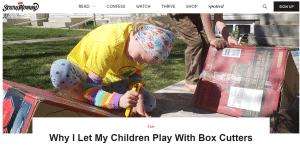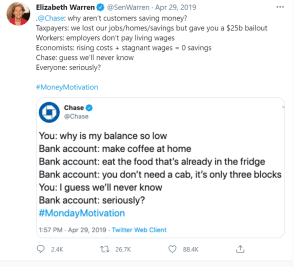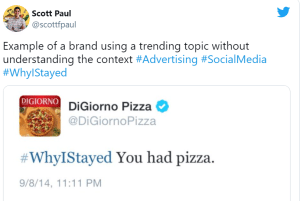
Why Content Marketing Needs More Snark And How We Use it
Snark content marketing is everywhere.
Wendy’s put snark on the map when they shot back at a Twitter troll who questioned their fresh beef commitment (and since then fast-food Twitter has become an all-out snarkfest).
More and more, brands are injecting healthy doses of humor — much of it snarky — into their social media, blogs, and even traditional ad campaigns. With millennials and gen Z’ers leading the charge, absurd humor about even the most serious issues (climate change jokes, anyone?) has become the norm.
So incorporating snark into your content is a good strategy, right?
The short answer — yes. Content marketing needs more snark because it’s entertaining, it resonates with audiences, and it makes brands feel authentic.
The longer answer? Yes, when you know what you’re doing. Snark can hurt more than it helps when you just use snark for snark’s sake (aka you’re forcing it) or your snark crosses into jerk territory.
Getting it right is a must when you’re using snark, but once you do, you’ll have more entertaining content that makes your brand more genuine to the audiences you’re trying to engage.
Quick Takeaways
- Snark makes your content more relatable and it makes your brand more authentic
- TikTok users and other influencers have already mastered snarky content based on shared experiences, and content marketers need to do the same
- It’s important to read the room when you’re using snark — otherwise, you risk public brand mishaps
Make Your Snark Relatable
Humor in general works because it plays off of shared context, so if you’re looking to add some snark to your content, one of the best places to start is with your customer’s experience. More specifically, the problem they’re trying to solve with your content.
Customers search for topics and ultimately end up reading brand blogs because they need answers or solutions. Snarky content finds the humor in a situation and directly calls out the frustrating or annoying aspects of it, making the content more relatable and its consumer feel understood.
There’s one place on the internet where relatable snark abounds: TikTok.
Most TikTokers aren’t brands (although they’re certainly monetizing their content), but they are absolute experts at building followings with snarky content based on shared experiences — and this past year has offered ample opportunity to get snarky about life in general.
Rod Thill grew a follower base of nearly 1 million in a year with his content about millennial work-from-home anxiety.
@rod Just two of many guests I have throughout the work day #work #workfromhome #corporate #office
Trey Kennedy is “totally like literally relatable” in his videos about life in quarantine. This one “went viral” last spring. (Some very subtle snark there btw!)
@treynkennedy Day 1 in #quarantine vs. day 50
Personal blogs do it, too. Scary Mommy is a blog started in 2008 by Jill Smokler that gained popularity with its snarky take on parenthood (and jabs at Mommy Bloggers who tried to make it look perfect). Today, it’s a huge community with lots of contributors — but still full of snark.

Brands Need Snark, Too
In the memefied world of the internet today, customers aren’t afraid of a little self-deprecating humor and brutal honesty. In fact, not beating around the bush tells your customer that you get it (whatever it is) and that you’ve got honest answers.
This kind of direct, stand-out-from-the-crowd tone matters in a time when a search for any topic yields millions of results to sift through (most of which will say the same things and link the same sources) and has created more informed customers than ever before.
When you add a little personality to your content using snark, it shows your customer you aren’t just churning out content without thinking — you understand their need and because of that, you’re best able to offer a solution.
It’s happening on social media, but content marketing needs snark too. I believe most marketing sucks because too many miserable marketers are just pushing our ads and campaigns no one wants. So I use snark to try and reach the marketers who believe that what we do can have meaning and impact.
Here’s an article I wrote a few years ago about brand personas, a marketing tool that is absolutely useful but often glossed over (even by “experts”) without thinking about how they can really be most effective.
I knew fellow marketers who shared the sentiment. I wanted to write about it, but instead of going with a simple “Good vs. Bad Personas” article, I decided to get right to the point:

Same with banner ads. We all know (shared experience) that we just don’t click them (and when we do it’s by accident).
So in this reference to a NSFW song by Jay-Z, I talk about how banners have 99 problems and a click ain’t one. Clever right?

I did my best to give my honest take on both of these topics because they frustrated me. In a way, writing them was therapy for me and hopefully relatable for my colleagues and peers.
Don’t Force It (and Don’t Be a Jerk)
Remember, too: funny content takes practice. It almost never comes out perfectly on the first try, and even though humor sounds natural when it’s delivered, it can take a few tries before it hits the mark (even the best comedians test out their jokes before they take the big stage).
The point? Don’t sit down and expect the snark to pour out with no effort. But also (and more importantly), don’t force it when it’s just not there.
Always ask yourself whether your snark really is relevant to your topic.
Are you using a funny example that drives your point home, or are you thinking up a joke just to add snark for snark’s sake? Are you trying to fit your snark around other content you’re seeing, even if it doesn’t necessarily fit with your brand?
Rule of thumb: If it doesn’t feel on-brand, the snark isn’t worth it (and the snark won’t resonate anyway when it’s not genuine).
Most importantly: don’t be a jerk.
You’ve got to read the room whenever you’re using snark. The internet has been an awesome way for brands to connect directly with customers, but it’s also been an easy way for customers to blast brands who they feel are out of line.
Chase tried to jump on a popular meme trend last year about overspending, and maybe at another time it would have gotten a laugh. During a pandemic? Not so much. They even got called out by Elizabeth Warren, giving more unfortunate visibility to their mishap.

DiGiorno tried to get snarky about pizza using a trending hashtag, except they didn’t actually research the hashtag first (it was about domestic violence). Yikes.

Putting it All Together
Snark is your friend when it’s used the right way, and in content marketing, it presents a great opportunity to show your customers you aren’t just here to make a profit — you really get it and you’re a relatable, approachable (and funny!) brand who can help.
If you’re thinking about ramping up the snark in your content marketing, get in touch to find out how we can help! We’ll probe you and your audience for frustrations everyone feels but maybe aren’t discussing in their content. And then we’ll put an insightful spin on how to overcome them.
What do you say? Give us a shout!






